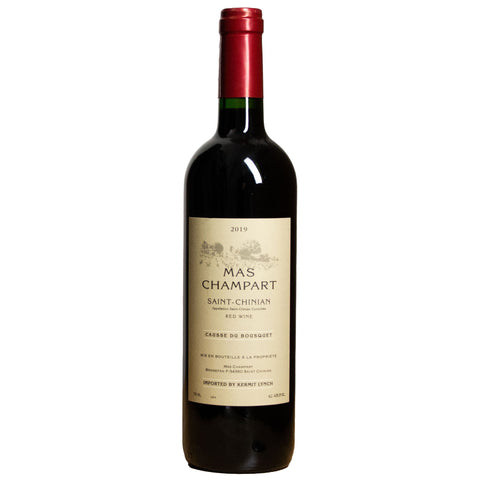
2019 Mas Champart Saint-Chinian "Causse Du Bousquet", Languedoc-Roussillon, France
Darker black and red fruits with a spicy, stoniness.
ABOUT THIS WINE
Made mostly from Syrah—with a splash of Grenache, Mourvèdre, Carignan, and Cinsault—this cuvée is all about the terroir. The name “Causse du Bousquet” describes the vineyard where this wine originates, translating roughly from the regional Occitan language to “limestone plateau where the rock rises to the surface.” Along with soulful, dark fruit, you can taste the stoniness in the wine. Cool it down, decant it in any kind of vase you have handy, and serve it the next time you fire up your grill.
• Most of the fruit is sourced from a lieu-dit called Le Bosquet
• Grapes undergo a cold maceration, followed by 3-6 weeks in cuve
• 100% of grapes are de-stemmed
• The Syrah is aged in barrels, the others grapes are aged in demi-muids for at least 12 months, and then blended and aged in cuve for 8 months
• Bottled unfined and unfiltered
ABOUT THIS PRODUCER
Isabelle and Matthieu Champart were relatively new to winegrowing when they first took over Domaine Bramefan (as her family’s farm is also known), in Saint-Chinian, in 1976. Isabelle was a Parisian with a degree in Geography, while Matthieu came from a family of farmers in Champagne. For nearly twelve years they sold their grapes to the local cooperative. Though they waited until 1988 to bottle under their own label, they won almost instant acclaim, and have become the standard against which other producers in the appellation have been measured ever since. Matthieu tends to the vines, and Isabelle makes the wines—that their home is surrounded by their vineyards makes their division of labor all the more poetic. The Champarts have made significant changes to their business over the years. While the domaine started from just a simple, humble, stone farmhouse, they later added a winery and have expanded the holdings from eight to twenty-five hectares (sixteen of which are consecrated to vineyards, the remaining nine to arable crops and orchards). The terroir here is a patchwork of soils: steep slopes of clay and limestone (Mourvèdre), brightly colored marl (Carignan & Syrah), limestone (Syrah & Grenache) and lower slopes of clay and sandstone (Cabernet Franc). They live among their old vines on a gentle slope and have slowly started integrating more organic practices into their farming. Though the wines are easy to appreciate now for their inky complexity, they age extremely well and shine after some decanting.
